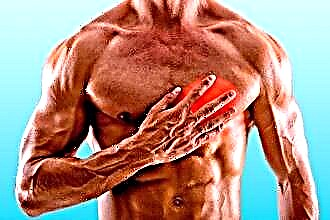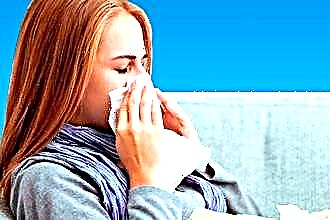Angina is an otolaryngological disease that mainly affects the mucous membrane of the throat and lymphadenoid tissues (palatine and pharyngeal tonsils). Untimely therapy of pathology in childhood can cause systemic complications, which is due to the practical absence of acquired immunity.
 Acute tonsillitis (tonsillitis) in the overwhelming majority of cases occurs against the background of the development of bacterial, less often fungal and viral flora.
Acute tonsillitis (tonsillitis) in the overwhelming majority of cases occurs against the background of the development of bacterial, less often fungal and viral flora.
During the selection of suitable drugs for the elimination of angina, the patient's age, the type of infectious agent, the degree of damage to the ENT organs and the presence of complications are taken into account.
Treatment of very young children is complicated by the body's hypersensitivity to the effects of antibiotics, as well as the impossibility of using local therapies: rinsing, inhalation, etc.
Treatment principles
How to treat angina in a child under 3 years old (children at 1, 2 and 3 years old)? Infectious-allergic inflammation in the mucous membrane of the oropharynx is fraught with generalization of pathological processes. Due to the low resistance of immunity to pathogens, the disease progresses very quickly. That is why self-medication often leads to the development of sinusitis, myocarditis, pyelonephritis, rheumatic heart disease and other serious diseases.
The principles of treating tonsillitis are largely determined by the causative agents of the infection. For the treatment of various types of pathology, the following drugs of etiotropic action are used:
- follicular and lacunar tonsillitis - antibiotics;
- herpetic tonsillitis - antiviral agents;
- candidal tonsillitis - antimycotic drugs.
The scheme of conservative treatment of pathology includes palliative medicines, i.e. symptomatic action. They relieve the symptoms of tonsillitis and help to eliminate local manifestations of the disease:
- analgesics;
- antipyretics;
- antihistamines;
- anti-inflammatory drugs.
In the first year of life, the child is not able to dissolve pills, gargle or inhale. Therefore, topical preparations are included in the complex therapy of acute tonsillitis, starting from two to three years.
Treatment of children at 1 year
How to cure a sore throat in a child at the age of 1 year? Treatment, as a rule, is carried out in an inpatient setting, due to the rapid progression of the infection. Severe edema of the pharyngeal mucosa can provoke respiratory disturbances, which is fraught with suffocation.
The development of bacterial flora can be stopped only with the help of systemic antibiotics. Oral administration of drugs in one year increases the risk of developing an allergic reaction and intestinal syndrome. Therefore, drugs are introduced into the body parenterally, i.e. bypassing the digestive tract.
Due to the lack of acquired immunity, the symptoms of tonsillitis in one-year-old children are poorly expressed. The following signs may indicate infection of the ENT organs:
- lack of appetite;
- capriciousness;
- lethargy;
- poor sleep;
- tearfulness;
- labored breathing;
- enlarged lymph nodes;
- hyperemia of the throat mucosa.
Only the attending pediatrician can determine the optimal course of treatment of pathology after receiving the results of the analysis of bacterial culture from the pharynx.
Drug overview
The danger of infectious-allergic inflammation lies in the intoxication of the body. Angina in a 1 year old child is characterized by severe edema of the ciliated epithelium lining the surface of the throat. Untimely relief of catarrhal processes leads to the spread of bacterial flora into the paranasal sinuses, as a result of which sinusitis and other pathologies of the nasopharynx occur.
What should be the treatment? A one-year-old baby is unable to swallow a pill or suck a lollipop. Therefore, all drugs of pathogenetic action, namely antibiotics and sulfonamides, are administered either intramuscularly or taken orally in the form of suspensions or syrups. In pediatrics, penicillins or macrolides are used to treat infectious diseases in preschool children. They practically do not cause irritation of the gastric mucosa and do not provoke side effects:
- Sumamed is a macrolide antibiotic with bacteriostatic effect; used to treat acute tonsillitis, otitis media and local post-infectious complications;
- "Augmentin" is a broad-spectrum drug that destroys aerobic and anaerobic bacteria, as well as strains of pathogens that synthesize beta-lactamase; contributes to the elimination of acute and chronic inflammation in the ENT organs;
- "Amoxiclav" is a drug of combined action, the components of which form stable compounds with the protein components of microbes, which prevents their reproduction.

Important! Drug overdose can cause diarrhea, flatulence and skin rashes.
The dosage of drugs is determined by the patient's weight and age during consultation with the pediatrician. At the stage of acute inflammation, the child is prescribed anti-inflammatory and antipyretic drugs. To reduce the likelihood of allergic reactions, antipyretics in the form of rectal suppositories are included in the treatment regimen. Among the most effective antipyretic drugs are Panadol, Efferalgan, Tsefekon D, etc.
Treatment of children at 2 years old
How to treat a sore throat in a child at 2 years old? At this age, children are able to complain of discomfort in the throat, general malaise, myalgia and weakness. If pathological signs occur, you need to seek help from a pediatrician. After a thorough examination, the specialist will be able to determine the type of tonsillitis and draw up the optimal therapy regimen.
In order to prevent metatonsillar pathologies, patients are often prescribed bicillin prophylaxis.
 It should be understood that a 2-year-old child is not able to gargle or dissolve pills, therefore, only aerosols and sprays can be prescribed as topical preparations. It is possible to eliminate the bacterial flora in the tonsils with the help of penicillins, cephalosporins and macrolides. Antimicrobial agents interfere with the biosynthesis of peptidoglycan, which is involved in the formation of bacterial cell structures. This prevents their further development, which accelerates the regression of inflammation.
It should be understood that a 2-year-old child is not able to gargle or dissolve pills, therefore, only aerosols and sprays can be prescribed as topical preparations. It is possible to eliminate the bacterial flora in the tonsils with the help of penicillins, cephalosporins and macrolides. Antimicrobial agents interfere with the biosynthesis of peptidoglycan, which is involved in the formation of bacterial cell structures. This prevents their further development, which accelerates the regression of inflammation.
Features of pharmacotherapy
Treatment of angina in a 2-year-old child begins with the intake of antibacterial agents of the penicillin series. In about 25% of cases, the components of the drugs provoke allergic reactions in patients, as a result of which they are replaced by macrolides - the least toxic antibiotics. Complicated angina is treated with cephalosporins, which are broad-spectrum drugs. The active ingredients of medicines are resistant to most strains of gram-positive and gram-negative bacteria.
As a rule, a sore throat in a 2-year-old child is treated with drugs such as:
- "Zitrolide" is an antibiotic-azalide of bacteriostatic action, which is used to treat tonsillitis complicated by otitis media, pneumonia, pharyngitis, etc .;
- "Azithromycin" is a macrolide preparation of a wide spectrum of action, the components of which interfere with the replication of DNA and RNA, as a result of which the reproductive function of pathogenic microbes is impaired;
- "Ceftriaxone" is a cephalosporin antibiotic that inhibits the synthesis of cellular structures of pathogens, which leads to their death; used in the treatment of infectious pathologies of the upper and lower respiratory tract.
 For the treatment of children 2 years old, you can use topical antiseptic preparations in the form of sprays. Their components are quickly absorbed into the throat mucosa, which speeds up the process of destroying pathogenic bacteria. Effective and safe means include: "Hexoral", "Miramistin", "Stopangin" and "Cameton".
For the treatment of children 2 years old, you can use topical antiseptic preparations in the form of sprays. Their components are quickly absorbed into the throat mucosa, which speeds up the process of destroying pathogenic bacteria. Effective and safe means include: "Hexoral", "Miramistin", "Stopangin" and "Cameton".
A child at two years old cannot hold his breath, therefore, in order to prevent laryngospasm, aerosol applicators should be aimed at the sky, and not at the tonsils.
Treatment of children at 3 years old
How to treat angina in a 3-year-old child? The complex therapy includes medicines of different pharmacological groups. Antibacterial agents for patients aged 3 years are available in the form of suspensions (powders) and syrups. Most of them have a pleasant fruity taste, which makes it much easier to take medication.
Important! Do not give antibiotics of the tetracycline group to preschool children due to their high toxicity.
Children from three years old are allowed to give topical preparations in the form of lozenges and lozenges. Physiotherapeutic procedures such as throat debridement and inhalation are also included in the treatment regimen. With their help, it is possible to quickly stop local manifestations of pathology, which speeds up the healing process.
With increased sensitivity of the body, it is advisable to use decoctions based on medicinal herbs as rinsing solutions. They have pronounced antibacterial and anti-inflammatory properties:
 St. John's wort;
St. John's wort;- chamomile;
- sage;
- eucalyptus;
- calendula;
- thyme.
In the presence of purulent inflammation, it is strictly forbidden to use steam inhalations.
In pediatrics, inhalation is carried out using nebulizers, which can be used to treat the upper respiratory tract in patients from 1.5 years of age. Unlike steam inhalers, they convert medicinal solutions not into hot steam, but into an aerosol at room temperature. This eliminates the likelihood of burns on the pharyngeal mucosa after inhalation.
Drug treatment regimens
Treatment of angina in children 3 years old is carried out mainly at home. To reduce the likelihood of complications, the patient must strictly adhere to bed rest for 5-7 days. In the presence of subfebrile and febrile fever, the child is provided with an abundant drink in the form of fruit juices, mineral water, green tea, fruit drinks, compotes, etc.
For the treatment of tonsillitis at three years old, the following types of drugs can be used:
- antibiotics - "Clarithromycin", "Cefotiam", "Ampiox";
- lozenges - "Faringosept", "Trakhisan", "Hexoral Tabs";
- antiallergic drugs - Suprastin, Erius, Tavegil;
- sprays and aerosols - Stopangin, Grammidin, Tantum Verde;
- rinsing solutions - Miramistin, Furacilin, Givalex;
- antipyretics - "Tsefekon", "Effarolgan", "Paracetamol";
- vitamins - "Multitabs", "Vitrum", "Aevit".
Important! Aerosols containing components of local irritating action ("Lugs", "Iodinol") should not be used more than 2 times a day.
Antiviral therapy
 For the treatment of angina of viral etiology, antibacterial agents cannot be used. The causative agents of pathology are not bacteria, but viruses that are not sensitive to the effects of antimicrobial agents. How to treat a viral sore throat in a 3-year-old child?
For the treatment of angina of viral etiology, antibacterial agents cannot be used. The causative agents of pathology are not bacteria, but viruses that are not sensitive to the effects of antimicrobial agents. How to treat a viral sore throat in a 3-year-old child?
ENT disease most often occurs against the background of ARVI, characterized by damage to the upper respiratory tract. The provocateurs of pathological processes are adenoviruses, herpes virus, rhinoviruses, etc. The following antiviral agents are used as drugs of pathogenetic action:
- "Citovir 3";
- "Viferon";
- Ergoferon;
- Anaferon.
To increase non-specific immunity, immunostimulants are used that activate the work of T-lymphocytes and phagocytes, which destroy pathogenic virions. To reduce the likelihood of adverse reactions, you can use drugs that do not include preservatives and synthetic flavors:
- Transfer Factor;
- Roncoleukin;
- "Dekaris";
- "Timogen".
Antipyretic drugs can be used only if the temperature exceeds 38.5 degrees. If the hyperthermia does not go away within a few days, you need to seek help from a specialist. Febrile fever may indicate the addition of a bacterial infection and the development of purulent processes in the tonsils.

 St. John's wort;
St. John's wort;

